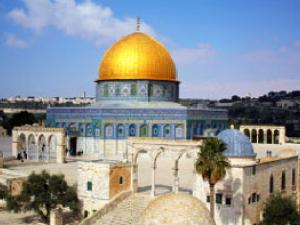Short Description
The Dome of the Rock was built at the very summit of the Haram complex, and is thus one of the most impressive and notable buildings of the city. It has an octagonal footprint, from which rises a 20 meter dome that was originally covered in lead sheets. Calligraphy adorned both
The Haram al-Sharif
For decades, this simple structure built by ‘Umar remained the main building on the Haram. In 690, however, the caliph ‘Abd al-Malik of the Umayyad Dynasty rebuilt the al-Aqsa Mosque, much larger and more stable than the mosque that ‘Umar had built. The basic plan of the current mosque dates from this reconstruction. ‘Abd al-Malik’s real architectural achievement however, was what was constructed about 200 meters to the north.
Above the rock from which some Muslims believed Prophet Muhammad ) PBUH) ascended to Heaven from, ‘Abd al-Malik built the magnificent Dome of the Rock. As part of the al-Aqsa Mosque, it was not a separate house of worship, nor was it meant to compete with the al-Aqsa Mosque, but was meant as a complement to it.
Using the architectural traditions and mosaics that the Umayyads had learned from the Byzantines who ruled the area before them, the Dome immediately became one of the focal points of Islamic architecture in the 600s.
The Dome of the Rock was built at the very summit of the Haram complex, and is thus one of the most impressive and notable buildings of the city. It has an octagonal footprint, from which rises a 20 meter dome that was originally covered in lead sheets. Calligraphy adorned both the inside and outside of the building, with some of the oldest existing Quranic inscriptions being inside the dome of the building.
Given the magnificence of the building, some modern historians have argued that ‘Abd al-Malik intended the building to be a rival to the Ka’bah in Makkah. Had he intended to do so, Muslim scholars of the time would have no doubt expressed outrage and recorded his blasphemous intentions in books written during that time.
However, there exists no contemporary account of him having such an intention, and the earliest mention of this idea was written 200 years later, by someone with a strong anti-Umayyad bias.
After the fall of the Umayyads in 750, Jerusalem came under the control of the ‘Abbasid Dynasty. The new ‘Abbasid caliphs had their capital in the Iraqi city of Baghdad, and did not put as much emphasis on Jerusalem as the Umayyads had. As such, the Haram did not receive the attention and money it had during the Umayyad period.
Nevertheless, despite the neglect it received from the caliphs, Jerusalem continued to be an important place of pilgrimage, and the al-Aqsa Mosque itself remained as the center of Islamic life in the city from the 600s through the 900s, despite many earthquakes during this period, which required numerous renovations.
To be continued.............






![نصيحتي لك: اذكر الله [1 / 12] نصيحتي لك: اذكر الله [1 / 12]](https://300035.dotdothktrade.tech/images/upload/content_thumbs/1913613138ragheb-al-serjany-videos.jpg)


Comments
Send your comment